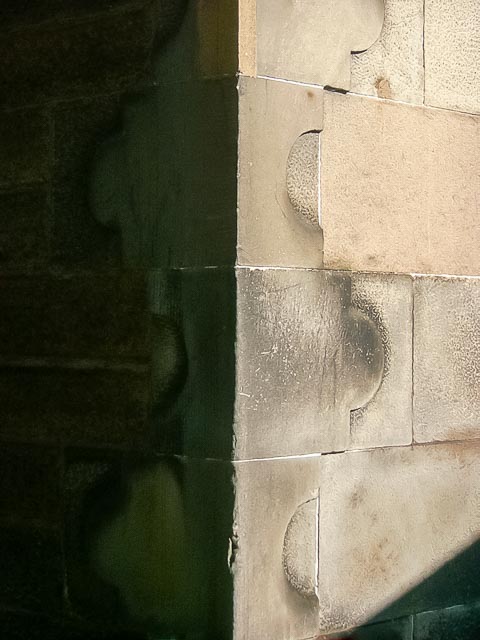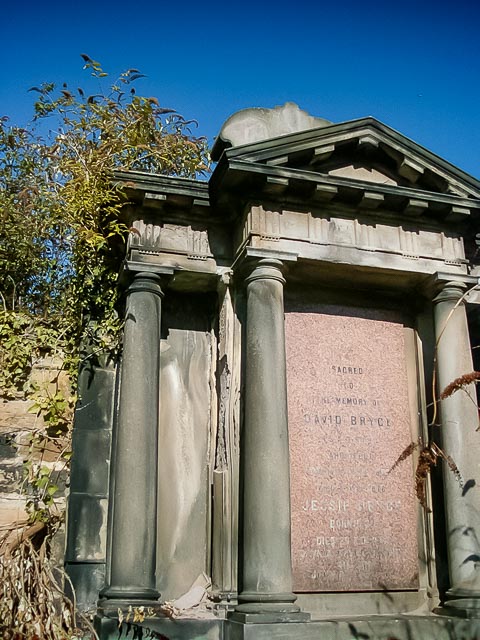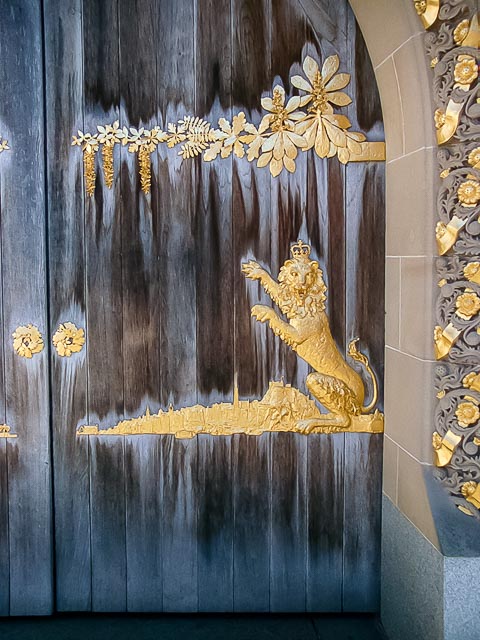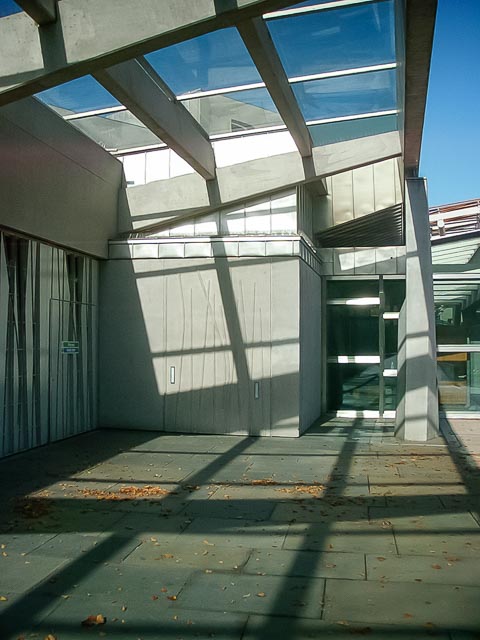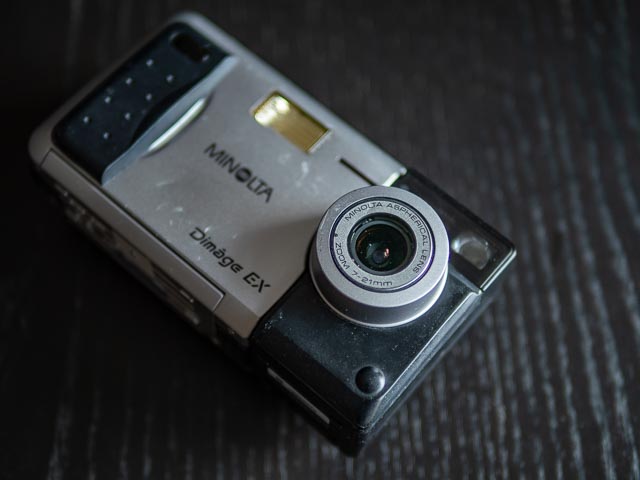Minolta DiMÂGE EX Zoom 1500

Introduction
| Launch date | August 1998 |
|---|---|
| Camera type | Compact digicam with interchangeable lens/sensor modules |
| Camera size | 380 grams 128 x 68 x 59 mm (inc. battery) |
| Sensor type | CCD |
| Sensor size | 1/2" (6.4 x 4.8 mm) |
| Resolution | 1344 x 1008 (1.35 megapixel) |
| Memory card | Compact Flash (maximum size 32mb) |
| Battery | AA x 4 |
| Lens | Minolta Aspherical Lens Zoom 7-21mm (35mm equiv. 38–115mm) |
If you just want to see some photographs, skip straight to the results section.
Back in 2009, Ricoh launched the innovative, daring, bonkers, and ultimately doomed, Ricoh GXR system. This system consisted of a body with the rear monitor and all the camera controls, but no lens or sensor. To form a complete camera you needed to add one of a series of sealed lens/sensor modules (often referred to using the awful portmanteau "lensors"!). It was one of those systems that achieved very little commercial success, but a decade and a half later has gone on to achieve an almost mythical status amongst retro-digital camera geeks! But did you know the Ricoh GXR was not the first such camera system? Oh no! More than a decade earlier Minolta (a famous old Japanese brand that quit the camera business altogether back in 2006) launched the camera you see here, the Minolta DiMÂGE EX.
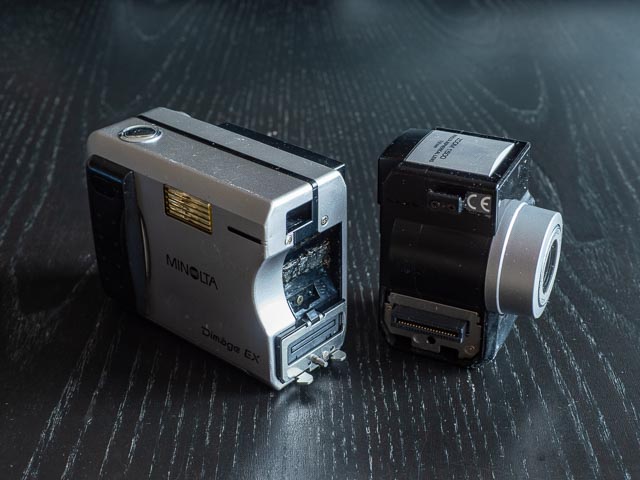 Minolta had even less success with the DiMÂGE EX than Ricoh had with the GXR. Quite why Ricoh though that could make the idea work when Minolta had already failed is one of digital photography's great mysteries! Minolta discontinued the DiMÂGE EX after making just 2 lens/sensor modules: Both had 1/2" (6.4 x 4.8 mm) 1.5mp CCD sensors, one with a 7-21mm (35mm equiv. 38–115mm) 3x zoom lens and a second with a 5.2mm (35mm equiv. 28mm) wide angle lens.
Minolta had even less success with the DiMÂGE EX than Ricoh had with the GXR. Quite why Ricoh though that could make the idea work when Minolta had already failed is one of digital photography's great mysteries! Minolta discontinued the DiMÂGE EX after making just 2 lens/sensor modules: Both had 1/2" (6.4 x 4.8 mm) 1.5mp CCD sensors, one with a 7-21mm (35mm equiv. 38–115mm) 3x zoom lens and a second with a 5.2mm (35mm equiv. 28mm) wide angle lens.
With the former, the complete camera was known as the Minolta DiMÂGE EX Zoom 1500, and with the latter it was known as the Minolta DiMÂGE EX Wide 1500. You could even buy an cable that allowed you to use the lens/sensor module at a distance. It's worth bearing in mind that when this system was launched it was almost unheard of to find a digital camera with a field of view any wider than 38mm on a 35mm camera, so existence of the 28mm wide unit was reason enough for this system to generate plenty of excitement when it was launched.
Buying a Minolta DiMÂGE EX Zoom 1500 in 2025
All digital cameras from the 1990s are becoming quite rare and difficult to find these days, but this one really is quite rare now particularly with the Wide 1500 lens/sensor module. It's far more common with the Zoom 1500 module, but still not that easy to find. But despite it's rarity, it really isn't worth very much: I paid just under than 30 quid for mine in September 2025 in slightly rough, but fully functioning, condition.
Shortly later I saw another example with both the Zoom 1500 and Wide 1500 lens/sensor modules, and the remote cable, in a German listing on eBay for 130 Euros. That seemed an awful lot of a digicam with only 1.5 mega pixels, so I hesitated and missed out. But of course now I which I'd just gone for it… I'll probably never see another one like it!
Fortunately, because this camera uses standard AA batteries and removable Compact Flash memory cards, I had everything I needed to get it up and running in the gear cupboard. That's not always the case with these early digicams! But if you're reading this because you're planning on adding a Minolta DiMÂGE EX to your collection, then remember you'll need memory cards of 32mb or less for a camera as old as this.
Minolta DiMÂGE EX Zoom 1500 body tour
The Minolta DiMÂGE EX Zoom 1500 is a pretty simple camera to use. There is no manual control over either shutter speed or aperture, and as was common at the time there is way to use this camera as anything other than base ISO (according to the specs in the manual this is 125 ISO). Actually that last statement isn't completely true! This camera is based on the Digita digital camera operating system (just like the Pentax EI-2000 I wrote about back in 2023) which offers the possibility of writing custom scripts to control this kind of thing, but unless you're comfortable getting your hands dirty with some computer programming, you're stuck at 125 ISO.
 Apart from the shutter button on the camera's top plate, all the controls are on the back of the camera: On the top right there is a four-way controler that serves various functions at different times, but when in shooting mode you'll mainly use this to control the zoom function (assuming you have the Zoom 1500 lens/sensor module installed). Just to the right of the rear monitor there is a slider switch to set the camera to discrete modes for shooting and playback, and under the rear monitor are 3 soft buttons whose function at any moment in time is displayed on the monitor above.
Apart from the shutter button on the camera's top plate, all the controls are on the back of the camera: On the top right there is a four-way controler that serves various functions at different times, but when in shooting mode you'll mainly use this to control the zoom function (assuming you have the Zoom 1500 lens/sensor module installed). Just to the right of the rear monitor there is a slider switch to set the camera to discrete modes for shooting and playback, and under the rear monitor are 3 soft buttons whose function at any moment in time is displayed on the monitor above.
 Under the soft buttons is a rotary control labelled 'bright' to set the monitor brightness and buttons for displaying the camera status, turning the soft button labels on and off, and entering the menu system. Next to these button you'll see the main power button.
Under the soft buttons is a rotary control labelled 'bright' to set the monitor brightness and buttons for displaying the camera status, turning the soft button labels on and off, and entering the menu system. Next to these button you'll see the main power button.
On the lens/sensor module you'll see the tunnel-type viewfiner with a couple of indicator lights for flash status and successful focus acquisition. You also see the final two buttons: one for turning the display on and off (useful for saving battery power when using the optical viewfinder) and entering macro mode (you'll only find this button on the Zoom 1500 module only as the Wide 1500 module doesn't have a macro mode). While we're talking about the lens/sensor module, it's worth pointing out that there is no hint of a lens cap or any other way to protect the lens, so you have to be careful how you carry and store this camera.
On the bottom of the camera you'll find the battery/memory card compartment and a trip bush. Next to this compartment you see a slider labelled 'release' to release the lens/sensor module.
Using a Minolta DiMÂGE EX Zoom 1500 in 2025
I found it very interesting to compare this camera to the only other camera I have that is as old or older: the Agfa ePhoto 1280 from 1997. I found the Agfa ePhoto 1280 to be a surprisingly pleasant and convenient camera to use, but the results from the 0.8 mega pixel sesnor just weren't really good enough to enable truly satisfying prints to be created, even small 150 x 100mm 'enprints'.
The Minolta DiMÂGE EX Zoom 1500 is the complete opposite: with almost twice the pixel resolution I found that even A4 prints looked really very good, but it was pretty horrible to use! The worst thing was that by default this camera requires you to press a button to save the photograph you have just taken to the memory card (or another to delete it… Minolta called this "Instant Review" mode). This makes some sense when you consider how expensive memory cards were in 1998: according to an advert I found in the 10 October 1998 issue of Amateur Photographer, an 8mb Compact Flash card would set you back about £50! And that would only store around 5 images at the highest image quality setting. A 32mb card that stores about the same number of images as a 24 exposure roll of film would have cost about 3 times as much. So only saving the photos you really wanted made sense in 1998 (but in 2025 serves only to frustrate!).
But the problem is that the rear monitor on which you were supposed to make such judgements is rendered almost entirely useless by the faintest whiff of sunshine! Indeed at first I was blissfully unaware of this instant review mode, so I was happily taking pictures without any of them actually being recorded to the memory card. At first I though my camera was broken! Fortunately it turns out you can switch this instant review mode off, in which case all images are written to the card automatically (phew!), but it took some plowing through the manual to find out about this (see page 58). And of course this camera does have a basic tunnel-type optical viewfinder, but it isn't accurate enough to give you anything more than a general idea of your composition.
And that brings us to another pain point with this camera: the macro mode. The macro mode actually allows you to (potentially!) create some really very nice close-up images. But in macro mode the focal length becomes fixed you use the left/right buttons of the four way controller to focus manually rather than zoom. On the rear monitor a "Focus Aid Meter" (a graduated scale showing 10 levels of sharpness) is displayed to help you with this task. Your task, should you choose to accept it, is to adjust focus manually until the focus aid meter shows maximum sharpness. You can also try to adjust focus until the image on the monitor just looks sharp. But with either technique that terrible monitor is likely to frustrate even your best efforts. You really need to have your camera on a tripod, and without that tripod you're largely dependent on luck. But when lady luck smiles on you, you can get some lovely results. (See the last two images in the results gallery for example.)
And of course, all cameras from the 1990s are pretty slow by modern standards, but that fact that the DiMÂGE EX is dealing with what are unusually high resolution images for a 1998 digicam makes it even slower than many of its contemporaries.
Minolta DiMÂGE EX Zoom 1500 results
 So, not a nice camera to use then! But do the results make up for that? Well… actually… yeah, they do! I was kinda blown away by the results from this old thing. Let's not get too carried away though. This is still a 27 year old 1.5mp digicam, so it won't have you throwing out your
Hasselblad X2D 100C! (If it does, feel free to send it my way, ha ha!!) But I found I was able to make very nice A4 sized prints without any problem at all. And there was something distinctive about the colours produced by this camera which I found very attractive indeed.
So, not a nice camera to use then! But do the results make up for that? Well… actually… yeah, they do! I was kinda blown away by the results from this old thing. Let's not get too carried away though. This is still a 27 year old 1.5mp digicam, so it won't have you throwing out your
Hasselblad X2D 100C! (If it does, feel free to send it my way, ha ha!!) But I found I was able to make very nice A4 sized prints without any problem at all. And there was something distinctive about the colours produced by this camera which I found very attractive indeed.
One reason why I bought this camera is that I wanted to find out when compact digicams started to produce results that a photography enthusiast could use to make satisfying photographic prints. It turns out that in 1997 (at least judging by my 0.8mp Agfa ePhoto 1280) we weren't there yet. But just a year later (and a resolution hike to 1.5mp) really really did give us a camera capable of creating genuinely photographic prints. Though of course this still wasn't a camera with the kind of handling or features to satisfy a photography enthusiast. You needed to wait another few years for that.
